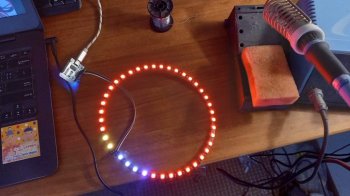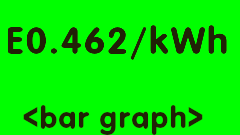PowerLight
| Project PowerLight | |
|---|---|

| |
| Show energy mix of dutch power generation as a pie chart on a LED ring | |
| Status | Completed |
| Contact | bertrik |
| Last Update | 2022-09-17 |
The concept
Draw the current dutch electrical power generation-mix as pie chart on a LED ring light, with colors representing fractions of a specific power generation source.
For example:
- yellow: solar
- blue: wind
- red: fossil
- green: nuclear
- grey: other/waste
Power generation data
Information about energy in Europe is collected at the european organisation https://www.entsoe.eu/ . The section about electrical energy is collected in ENTSO-E. Data is available from this platform at a 15-minute interval.
TenneT is the organisation that supplies ENTSO-E with data from the Netherlands.
Information about ENTSO-E generation domain API: https://transparency.entsoe.eu/content/static_content/Static%20content/web%20api/Guide.html#_generation_domain
Also possibly interesting (requires an API key), but might actually just use the entso-e data: https://static.electricitymap.org/api/docs/index.html#introduction
Power generation categories
The backend uses the following categories
ENTSO-E numbers the production types from B01 to B20 ("PsrType"), how these are filled for the netherlands:
- B01 (biomass): always 0, not useful
- B02: not available
- B03: not available
- B04 (fossil hard coal): useful
- B05 (fossil gas): useful
- B06: not available
- B07: not available
- B08: not available
- B09 (geothermal): not available
- B10 (hydro): not available
- B11 (hydro): always 0
- B12 (hydro): not available
- B13 (marine): not available
- B14 (nuclear): useful
- B15 (other renewable): not available
- B16 (solar): hugely underreported, *not* useful
- B17 (waste): useful
- B18 (wind offshore): useful
- B19 (wind onshore): useful
- B20 (other): useful
The solar power problem
In particular the solar power fraction is incomplete, but also the biomass figures are missing. See:
- https://berthub.eu/articles/posts/dutch-electrical-power-figures-2/ provides a nice overview of the current situation about dutch electrical power generation data
- https://energy-charts.info/charts/energy_pie/chart.htm?l=en&c=NL note how the solar part is tiny, even during the day
There is a model that estimates the solar fraction, also at a regional level, at https://api.netanders.io/, however use of this model requires a paid subscription.
What I'm currently doing for the solar fraction, is to use the ENTSO-E forecast instead of the actual solar numbers reported to them, see yesterday's wind/solar forecast. Perhaps this can also be done for the wind fraction.
Data schedule
Entso-E provides data with a resolution of 15 minutes. It appears to become available about 5m20s after the start of each 15 minute period (:00, :15, :30, :45). At that point, the most recent data is from an interval that ended 30 minutes ago. So, including the 5m20s minute processing delay, the most recent data available is about 35 minutes old.
Hardware
Parts:
- LED ring light https://nl.aliexpress.com/item/1005003798658173.html
- Wemos D1 mini with an ESP8266
Software
The software consists of two parts:
- The backend part that collects the power generation data, written in Java, running on a VPS
- The light part that visualizes the power generation as fractions on a LED ring, running on an Arduino
Backend
Source code: https://github.com/bertrik/energymix-server
Runs as a REST-like resource at:
- http://stofradar.nl:9001/electricity/generation with details about the current (35-50 minute ago) energy generation mix
- http://stofradar.nl:9001/electricity/price with day-ahead hourly price-per-MWh for today
(1-minute rate limit)
Returns a JSON-structure like:
{
"time": 1657057500,
"total": 9122,
"mix": [
{ "id": "solar", "power": 0, "color": "#FFFF00"},
{ "id": "wind", "power": 4, "color": "#0000FF"},
{ "id": "fossil", "power": 86, "color": "#FF0000"},
{ "id": "nuclear", "power": 5, "color": "#FF00FF"},
{ "id": "other", "power": 4, "color": "#444444"},
{ "id": "waste", "power": 1, "color": "#444444"}
]
}
- time is a unix time stamp in seconds, representing the end of the 15-minute period that the power figures refer to
- total is the total most recent electrical power (megawatt), suitable for display (on a numeric display inside the ring for example)
- mix is an array of power sources, each with:
- a short unique id
- most recent known power (megawatt)
- hex color, for display on the led ring
Energy generation sources are calculated from sources as follows, mostly from document A75:
- solar = B16 (from the *forecast* document A69)
- wind = B18 (offshore, from generation document A75) + B19 (onshore, from forecast document A69)
- fossil = B04 (gas) + B05 (coal)
- nuclear = B14
- waste = B17
- other = B20
Display
Powerlight
Shows the dutch energy generation mix by source. Source code: https://github.com/bertrik/PowerLight
The Arduino sketch polls the REST API using HTTP every minute.
WiFi is managed by WifiManager. LEDs are controlled using FastLED. JSON content is parsed using ArduinoJSON.
ElectricityPrice
Shows the current dutch electricity price, based on the day-ahead prices from yesterday. Source code: https://github.com/bertrik/ElectricityPrice
The Arduino sketch polls the REST price API using HTTP every 5 minutes. WiFi is managed by WifiManager. JSON content is parsed using ArduinoJSON.
Hardware is an ESP8266 controlling a 7-segment display based on a TM1637, on pins D3 and D4.
T-Display

Alternative: use a TTGO ESP32 T-Display.
It has a 240x135 pixel display. Plan is to show a kind of bar graph with 24 bars (one bar for each hour), each bar's height indicates the price of that hour. The background color shows green/black/red, to indicate cheap/moderate/expensive. Current price is shown as a big number.
Each bar is therefore 10 pixels wide, 9 pixels for the bar + 1 pixel separation.
SHA-badge
The SHA2017 badge has an ESP32 capable of performing the HTTP request, processing the JSON and displaying the result on its display. These badges are limited-edition, a few thousand of them were made for the SHA-2017 event and they're no longer being produced.
It has a 296x128 pixel epaper panel. So that could be a bar graph of 24 bars with a width of 12 pixels each, on the bottom 2/3rds of the display, and a current price on the top 1/3rd of the display.
Could be run as a micropython sketch. Alternatively could be run as an Arduino sketch.
Micropython:
- ++ possibly quick development, script can be shared with other people
- ++ has working libs for fetching HTTP, decoding JSON, controlling the display
- -- script needs frequent garbage collection to avoid crashing?
- -- unclear how to get a python script on this thing
- -- sha badge firmware bootloops, currently unusable to me
Arduino:
- ++ I know this environment, don't have to debug existing bootlooping firmware, no compiler setup required
- ++ Already have HTTP and JSON working on Arduino
- ++ Code starts immediately, no user interaction required
- -- not sure if there is a usable epaper driver